The California Air Resources Board is the "clean air agency" in the government of California. Established in 1967 when then-governor Ronald Reagan signed the Mulford-Carrell Act, combining the Bureau of Air Sanitation and the Motor Vehicle Pollution Control Board, CARB is a department within the cabinet-level California Environmental Protection Agency.
Vehicle emissions control is the study of reducing the emissions produced by motor vehicles, especially internal combustion engines.

Emission standards are the legal requirements governing air pollutants released into the atmosphere. Emission standards set quantitative limits on the permissible amount of specific air pollutants that may be released from specific sources over specific timeframes. They are generally designed to achieve air quality standards and to protect human life. Different regions and countries have different standards for vehicle emissions.
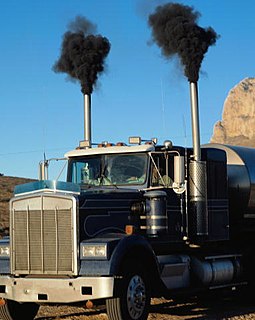
Exhaust gas or flue gas is emitted as a result of the combustion of fuels such as natural gas, gasoline (petrol), diesel fuel, fuel oil, biodiesel blends, or coal. According to the type of engine, it is discharged into the atmosphere through an exhaust pipe, flue gas stack, or propelling nozzle. It often disperses downwind in a pattern called an exhaust plume.
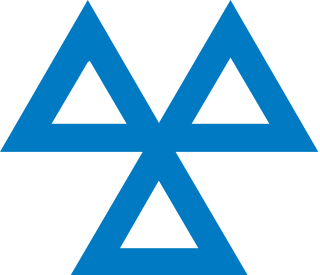
The MOT test is an annual test of vehicle safety, roadworthiness aspects and exhaust emissions required in the United Kingdom for most vehicles over three years old. In Northern Ireland the equivalent requirement applies after four years. The requirement does not apply to vehicles used only on various small islands with no convenient connection "to a road in any part of Great Britain"; no similar exemption is listed at the beginning of 2014 for Northern Ireland, which has a single inhabited island, Rathlin. The MOT test was first introduced in 1960 as a few basic tests of a vehicle and now covers 20 different parts or systems on or in the car.
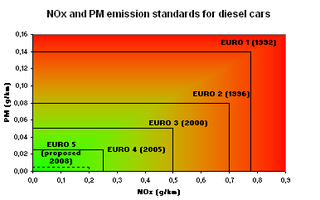
European emission standards are vehicle emission standards for exhaust emissions of new vehicles sold in the European Union and EEA member states. The standards are defined in a series of European Union directives staging the progressive introduction of increasingly stringent standards. Details of Euro 7, the final standard, will be announced in 2021 and probably come into force in 2025, before the phase-out of fossil fuel vehicles takes place to further limit climate change and air pollution in Europe. It is likely that manufacturers in the United Kingdom will also follow Euro 7, as they did the earlier standards. The details of Euro 7 are likely to be influenced by European Green Deal targets to reduce carbon dioxide emissions.
Type approval or certificate of conformity is granted to a product that meets a minimum set of regulatory, technical and safety requirements. Generally, type approval is required before a product is allowed to be sold in a particular country, so the requirements for a given product will vary around the world. Processes and certifications known as type approval in English are generally called homologation, or some cognate expression, in other European languages.
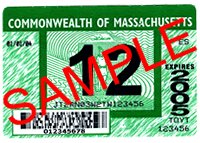
Vehicle inspection is a procedure mandated by national or subnational governments in many countries, in which a vehicle is inspected to ensure that it conforms to regulations governing safety, emissions, or both. Inspection can be required at various times, e.g., periodically or on the transfer of title to a vehicle. If required periodically, it is often termed periodic motor vehicle inspection; typical intervals are every two years and every year. When a vehicle passes inspection, often a sticker is placed on the vehicle's windshield or registration plate to simplify later controls, but in some countries—such as the Netherlands since 1994—it's no longer necessary. Inspection stations are places to drive inside to see if a vehicle passes inspection once a vehicle is due for inspection. Most US inspection decals/stickers display the month's number and the year.
HORIBA MIRA Ltd. is an automotive engineering and development consultancy company headquartered near Nuneaton in Warwickshire, United Kingdom. It provides product engineering, research, testing, information and certification services to the automotive sector. Its headquarters are in the MIRA Technology Park Enterprise Zone. On 14 July 2015 MIRA announced that it was being bought by the Japanese-owned testing equipment group Horiba.
The Regional Transport Office or Regional Transport Authority is the organisation of the Indian government responsible for maintaining a database of drivers and a database of vehicles for various states of India. The RTO issues driving licences, organises collection of vehicle excise duty and sells personalised registrations.
United States vehicle emission standards are set through a combination of legislative mandates enacted by Congress through Clean Air Act (CAA) amendments of 1970 and beyond, and executive regulations managed nationally by the Environmental Protection Agency (EPA), and more recently along with the National Highway Traffic Safety Administration (NHTSA). These standard cover common motor vehicle air pollution, including carbon monoxide, nitrogen oxides, and particulate emissions, and newer versions have incorporated fuel economy standards.

A car is a wheeled motor vehicle used for transportation. Most definitions of cars say that they run primarily on roads, seat one to eight people, have four wheels, and mainly transport people rather than goods.
The United Kingdom driving test is a test of competence that UK residents take in order to obtain a full Great Britain or Northern Ireland (car) driving licence or to add additional full entitlements to an existing one. Tests vary depending on the class of vehicle to be driven. In Great Britain it is administered by the Driver and Vehicle Standards Agency (DVSA) and in Northern Ireland by the Driver & Vehicle Agency (DVA).

The Clean Air Act is a United States federal law which limits national air pollution. Initially enacted in 1963 and amended in 1965, 1967, 1970, 1977, and 1990, it is one of the United States' first and most influential modern environmental laws, and one of the most comprehensive air quality laws in the world. As with many other major U.S. federal environmental statutes, it is administered by the U.S. Environmental Protection Agency (EPA), in coordination with state, local, and tribal governments.
Bharat stage emission standards (BSES) are emission standards instituted by the Government of India to regulate the output of air pollutants from compression ignition engines and Spark-ignition engines equipment, including motor vehicles. The standards and the timeline for implementation are set by the Central Pollution Control Board under the Ministry of Environment, Forest and Climate Change.
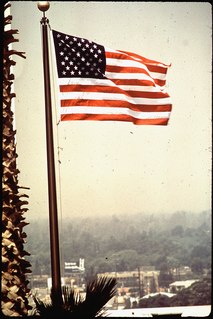
The California Smog Check Program requires vehicles that were manufactured in 1976 or later to participate in the biennial smog check program in participating counties. The program's stated aim is to reduce air pollution from vehicles by ensuring that cars with excessive emissions are repaired in accordance with federal and state guidelines. With some exceptions, gasoline-powered vehicles, hybrid vehicles, and alternative-fuel vehicles that are eight model-years old or newer are not required to participate; instead, these vehicles pay a smog abatement fee for the first 8 years in place of being required to pass a smog check. The eight-year exception does not apply to nonresident vehicles being registered in California for the first time, diesel vehicles 1998 model or newer and weighing 14,000 lbs or less, or specially constructed vehicles 1976 and newer. The program is a joint effort between the California Air Resources Board, the California Bureau of Automotive Repair, and the California Department of Motor Vehicles.
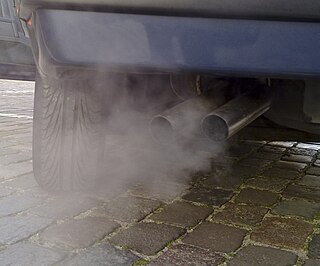
Mobile source air pollution includes any air pollution emitted by motor vehicles, airplanes, locomotives, and other engines and equipment that can be moved from one location to another. Many of these pollutants contribute to environmental degradation and have negative effects on human health. To prevent unnecessary damage to human health and the environment, environmental regulatory agencies such as the U.S. Environmental Protection Agency have established policies to minimize air pollution from mobile sources. Similar agencies exist at the state level. Due to the large number of mobile sources of air pollution, and their ability to move from one location to another, mobile sources are regulated differently from stationary sources, such as power plants. Instead of monitoring individual emitters, such as an individual vehicle, mobile sources are often regulated more broadly through design and fuel standards. Examples of this include corporate average fuel economy standards and laws that ban leaded gasoline in the United States. The increase in the number of motor vehicles driven in the U.S. has made efforts to limit mobile source pollution challenging. As a result, there have been a number of different regulatory instruments implemented to reach the desired emissions goals.

International Centre for Automotive Technology (iCAT) is located at Manesar in Gurugram district of Haryana state of India. The Rs 1100 crore facility has facilities for vehicle homologation and also testing laboratories for noise, vibration and harshness (NVH) and passive safety. It also includes a powertrain laboratory, engine dynamometers, emission laboratory with Euro-V capability, a fatigue laboratory, passive safety laboratory, and vehicle test tracks. iCAT is also being developed as a Centre of Excellence (CoE) for component development and NVH. ICAT has hosted the world class event NuGen Mobility Summit-2019 in November 2019 which was inaugurated by Nitin Gadkari, Union Minister of Road Transport and Highways and Micro, Small and Medium Enterprises, Government of India. NuGen Mobility Summit 2021 is scheduled to be held on 27-29 October 2021.

Rolling coal is the practice of modifying a diesel engine to increase the amount of fuel entering the engine in order to emit large amounts of black or grey sooty exhaust fumes into the air. Such modifications may include the intentional removal of the particulate filter. Practitioners often additionally modify their vehicles by installing smoke switches and smoke stacks. Modifications to a vehicle to enable rolling coal may cost from US$200 to US$5,000.

The Motor Vehicles Act is an Act of the Parliament of India which regulates all aspects of road transport vehicles. The Act provides in detail the legislative provisions regarding licensing of drivers/conductors, registration of motor vehicles, control of motor vehicles through permits, special provisions relating to state transport undertakings, traffic regulation, insurance, liability, offences and penalties, etc. For exercising the legislative provisions of the Act, the Government of India made the Central Motor Vehicles Rules 1989.












